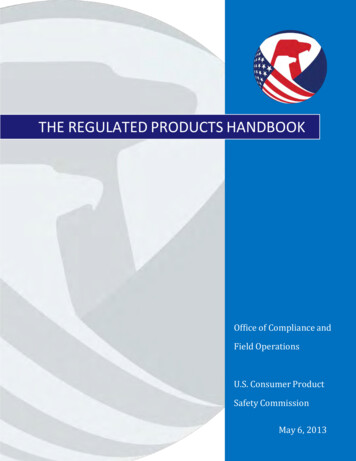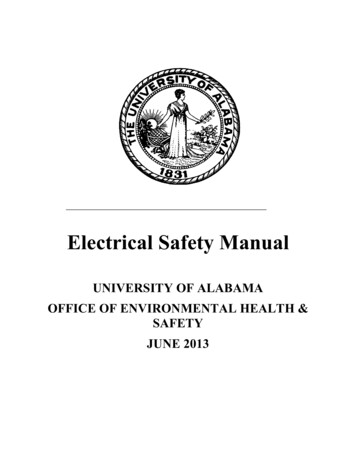
Transcription
HOME ELECTRICAL Safety ChecklistKeeping You and Your Family Safe, Room-by-RoomU.S. Consumer Product Safety Commission4330 East West HighwayBethesda, MD 20814Pub 513July 2008This document was prepared by CPSC staff, has not been reviewed orapproved by, and may not necessarily reflect the views of, the Commission.CPSC recommends performing theHOME ELECTRICAL Safety Checklistevery 6 months.DATE COMPLETED:Next Check-up:
ContentsHOMEELECTRICALSAFETYCHECKLISTIn All RoomsCONTENTSLightsPortable Electric Heating EquipmentThree Prong AdaptersElectrical CordsElectric Outlets and SwitchesOutlets with Ground Fault Circuit InterruptersALL ROOMSIn the KitchenEvery year, electrical products are associated with injuries, deaths,problems before they occur. This checklist is a room-by- roomguide and allows you to identify and follow up on safety concerns.inspecting electrical products in your home every six months.Each time you move into a home or change your clocks is theIn All BedroomsElectric BlanketsIn Basement, Garage, and Work AreasFuse BoxCircuit Breaker BoxAll Electrical Power ToolsBEDROOMSperfect time to check your smoke alarms and perform this checklist!Ground Fault Circuit InterruptersSmall Electrical AppliancesBATHROOMSThe U.S. Consumer Product Safety Commission staff recommendsIn All BathroomsKITCHENand fires in homes. Use this checklist to spot possible safetyCounter Top AppliancesLarge AppliancesOutside of Your HomeOTHERSOutletsElectrical Garden ToolsExtension Cords Used OutdoorsPools and SpasOUTDOORSPUBLICATIONS2www.cpsc.gov3
In ALL RoomsHOMEELECTRICALSAFETYCHECKLISTCheck LightsNO: Replace the bulb with thecorrect wattage bulb. If you aren’tsure, use a bulb 60 watts or less.For unmarked ceiling fixtures withminiature bulbs, use 25 watt bulbs.A bulb that is a higher wattagethan recommended may overheatthe light fixture , wiring or nearbycombustible materials, leading to afire.CONTENTSCheck each light in theroom, including lamps andceiling fixtures. Is each bulbthe appropriate wattage forits fixture?ALL ROOMSCheck Portable Electric Heating EquipmentNO: Move heater at least 3 feetaway from combustibles andcheck that nothing could fall orlean onto the heater.Some heaters can produce enoughheat to ignite nearby combustiblematerials.Is the heater stable andplaced where it will not tipover?NO: Place heater on a stablesurface and ensure it is out oftraffic.A fire hazard can result if a heater istipped over. Children, animals, oreven blowing drapes can knock aheater over. Although some heatershave tip-over switches, it is better tobe sure the heater is stable.Is the heater in goodworking order? (no oddsmells, sparks or smoke whenoperating)NO: Have the heater repairedor buy a replacement that has aseal (from a NRTL) on it.Operating problems often indicatean unsafe electrical condition thatcould cause fire or electrical shock.NO: Always connectthe grounding wire or metaltab on the adaptor to thecenter screw on the outlet cover.The grounding feature provided bya 3-prong adapter for a 2-prongoutlet is a safety feature designed tolessen the risk of fire or shock in caseof an appliance fault. NEVER defeatthe adapter’s grounding feature orbreak the ground pin from a 3-prongplug.OTHERSIs the heater placed at least 3feet from combustibles, suchas drapes and newspapers?BEDROOMSThere is less assurance thatsafety features are adequate forheaters not tested by a nationallyrecognized lab.BATHROOMSNO: Replace heater. Keep heatersfar away from all combustiblesand avoid touching themwhile plugged in and hot.Avoid using an uncertified heater.KITCHENDoes the heater have a sealof a nationally-recognizedtesting laboratory (NRTL),such as UL, ETL, or CSA?Check 3-Prong AdaptersOUTDOORSAre properly grounded3-prong adapters used toattach power cords with3-prong plugs to older 2-prongoutlets?PUBLICATIONSThere’s more for all rooms on the next page.4www.cpsc.gov5
Check Electrical Cords (including those on lamps and extension cords) andEntertainment Equipment (TVs, DVD players, computers, etc.)Damaged cords may have exposedlive wires that can be shock and firehazards.Is any cord placed where itmight be stepped on?YES: Move all cords so they areout of the path of foot traffic.Cords placed in the path of trafficare tripping hazards. Cords can bedamaged when stepped on, creatinga fire or shock hazard.Is any piece of furniture or rugresting on an electrical cord?YES: Move cords or furniture socords are not covered.Heavy weights or traffic can damagecords, crushing insulation orbreaking wire strands, creating a fireor shock hazard.YES: Remove any nails and/orstaples and replace damagedcords.Nails and staples can tear or crushthe insulation or cut the wires inside,presenting a fire or shock hazard.Are all extensions cordsequipped with safety coverson the unused outlets?NO: Use safety covers that fill theslots of every unused outlet.Children can be shocked or seriouslyburned when they play withuncovered outlets.Check the electrical ratingon appliances and extensioncords. Is any extension cordcarrying more that its properload?YES: Replace cord with a highercapacity cord (16 AWG handles1375 W, use 14 or 12 AWG forheavier loads).Too much current will cause the wiresto get hot. If the cord, plug, or outletfeels warm, it may be overloaded,and can be a fire hazard.Is any extension cord beingused on a permanent basis?YES: Have new outlets installedwhere needed, or move appliancecloser to an outlet.Extension cords are not as safe aspermanent house wiring. Installedwiring can carry more current and isprotected from accidental damagethat could cause shock or fire.Is all the equipment in adry location, free of any sourceof water, including rain, leaks,and spills?NO: Relocate equipment awayfrom water source such as plantsand aquariums.Mixing electricity and water canresult in a serious shock or firehazard.www.cpsc.govAre all outlets and switchescool to the touch?NO: Make sure appliances arenot overloading the outlet. Stopusing them until an electricianchecks the problem.Unusually warm outlets or switchesmay indicate an unsafe wiringcondition exists, such as a looseelectrical connection that can starta fire. (Some dimmer switches maybecome warm during normal use.)Do all electrical plugs fitsnugly into all outlets?NO: Have the outlet replaced.Loose-fitting plugs can causeoverheating and fires. A looseconnection cannot carry muchcurrent without getting hot.Do all outlets have faceplatescovering all wiring?NO: Install faceplates.Exposed wiring is a shock hazard.Children may stick objects into anelectrical outlet that is not coveredwith a plate.Check Ground Fault Circuit Interrupter (GFCI) Protected OutletsDo you test all your GFCI outletsregularly?Do you have GFCI outletsin- stalled in your:KitchenUnfinished BasementGarage orAround your laundry/ utilitytub or wet bar sinkNO: Test every GFCI once a monthaccording to the manufacturer’sinstructions.If you do not have the instructionsfollow this procedure:1) Plug a light into the outlet andturn it on.2) Press the test button. Did thelight go out? If not, replace theGFCI.3) Press the reset button. Did thelight come back on? If not,replace the GFCI.GFCIs can prevent electrocutionsso make sure they’re working.The CPSC recommends usingthem in kitchens, bathrooms, andother areas where the risk of electricshock is higher.Consider having GFCIs installedin locations required by theNational Electrical Code, such askitchens, bathrooms, garages,unfinished basements and nearlaundry tubs or wet bar sinks.Once you’ve completed this section for every room, continue onto the next page for specific items to look for in your kitchen.PUBLICATIONSBlocking air flow to equipment cancause overheating and a possible firehazard. (Refer to the owner’s manualfor guidance.)Improperly operating outlets orswitches may indicate that anunsafe wiring condition exists. Aloose screw holding a wire or a wornout switch can lead to electricalarcing, overheating, or a fire.OUTDOORSIs all the entertainmentequipment placed so that aircan freely circulate around it?NO: Move equipment so it hasroom to “breathe.” Avoid enclosingequipment in a cabinet withoutproper openings and do notstore papers around equipment.NO: Have an electrician check theoutlets and switches.OTHERSAre cords attached toanything (wall, baseboard, etc)with nails or wire staples?Are all outlets and switchesworking properly?BEDROOMSWrapped cords trap heat thatnormally escapes loose cords, whichcan lead to melting or weakening ofinsulation.Children can suffer serious shock andburn injuries if they insert objectsinto outlets.BATHROOMSYES: Unwrap cords.NO: Purchase safety covers for allunused outlets.KITCHENIs any cord tightly wrappedaround any object?If children are present, doall unused outlets have safetycovers?ALL ROOMSYES: Replace all damaged cords orreplace equipment.CONTENTS6Is any cord frayed, cracked, orotherwise damaged?HOMEELECTRICALSAFETYCHECKLISTCheck Electrical Outlets and Switches7
In The KitchenHOMEELECTRICALSAFETYCHECKLISTCheck Counter Top AppliancesAre all appliance cords placedso they will not come in contactwith a hot surface (e.g., oven,range burner, toaster)?NO: Relocate cords away from allheat sources.Cords can melt or burn from excessheat. This can expose wires, whichcould lead to an electrical shockor fire.Are all appliances located awayfrom the sink?NO: Relocate away from thesink area. If you can’t relocatethem, make sure the appliancesare plugged into GFCI-protectedoutlets.Mixing electricity and water canresult in an electric shock or firehazard. Counter top appliances canbe accidentally knocked into the sinkor sprayed with water. Using a GFCIreduces the chance of a serious shockor electrocution.Have you ever received even aslight shock (other than onefrom static electricity) from anyappliance?YES: Do not touch the applianceuntil it has been checked by anelectrician. Turn the power off tothe appliance at the circuit breaker.A shock indicates an extremelyhazardous wiring condition. Theremay be an internal electrical shortor ground fault that could seriouslyinjure someone who simply touchesthe appliance.Is the top of and area abovethe cooking range free ofcombustibles (e.g., potholders,paper, plastic utensils)?NO: Remove all possiblecombustibles.Using the range area for storage ofcombustibles may result in fires orburns.KITCHENUnattended, plugged-in appliancesmay create an unnecessary riskof fire.ALL ROOMSNO: Unplug when not in use.CONTENTSAre all counter top appliancesunplugged when not in use?BATHROOMSCheck Large ATIONS8Once you’ve completed inspecting the kitchen, continue on to the next pagefor specific items to look for in your bathrooms.9
In All BathroomsHOMEELECTRICALSAFETYCHECKLISTCheck Small Electrical Appliances (hairdryers, curling irons, electric razors, etc.)NO: Discard or have repaired.Irregular operation is a signof damage to electrical parts.Damaged appliances can become ashock or fire hazard.YES: Consider installing a fixedheating fan. Avoid using portableheaters in the bathroom. If you usea portable heater, either plug it intoa GFCI outlet or use a heater with aGFCI plug.Portable heaters can be anelectrocution hazard when used inbathrooms. The many groundedsurfaces and water contribute tothis hazard. A GFCI can help toreduce the risk of serious injury orelectrocution.That is, are they working thesame with no signs of damagedwiring or parts? (smoke, sparks,and noises, etc.)Are portable heaters ever usedin the bathroom?BATHROOMSAre all appliances in goodcondition?KITCHENEven when turned off, plugged-inelectrical appliances may cause ashock hazard if they fall into water.Sometimes a worn switch may turnon with no one touching it.ALL ROOMSNO: Unplug all small applianceswhen not in use.CONTENTSAre all appliances unpluggedwhen not in 10Once you’ve completed inspecting all your bathrooms, continue on to thenext page for specific items to look for in your bedrooms.11
In All BedroomsHOMEELECTRICALSAFETYCHECKLISTCheck Electric BlanketsAny of these conditions indicatedamage and a potential fire hazard.Is anything covering theblanket when in use?YES: Remove object. Do not allowanything on top of the blanketwhen it is in use.When covered by anything, includingother blankets or pets, electricblankets may overheat. If uncertainof your blanket instructions, do notput anything, even a light bedspreador blanket on top of an operatingelectric blanket.Is the blanket always laid outflat?NO: Unfold the blanket. Never foldelectric blankets when in use.Folded blankets may overheat.If tucked in, are the heatproducing wires bent aroundthe corners?YES: Untuck the blanket. Neverpinch the heat-producing wires.Pinching the wires may causedamage. Damaged wires may createa fire hazard.CONTENTSNO: Discard blanket.Are all electric blankets in goodcondition?Look for cracks or breaks inwiring, plugs, and connectors.Also look for dark, charred, orfrayed spots on either side ofthe blanket.ALL c.govPUBLICATIONS12Once you’ve completed inspecting all your bedrooms, continue on to the nextpage for specific items to look for in your basement, garage, and workshops.13
In Basement, Garage, and WorkshopsHOMEELECTRICALSAFETYCHECKLISTCheck Fuse Box (No fuse box? Check your Circuit Breaker box.)Are fuses the correct size forthe circuit?The wrong size fuse can allow toomuch current to flow and cause thewiring to overheat, creating a firehazard.CONTENTSNO: Install the correct size. Ifcorrect size is unknown, have anelectrician identify and label thesize to be used.ORCheck Circuit Breaker BoxNO: Test GFCIs monthly.GFCIs must be operating properly toprotect against electrocution. Theycan fail without showing any sign offailure, so regular testing may saveyour life. By installing GFCIs, you arereducing your risk of electric shock.To test: Push the test button. Thebreaker handle should go to themiddle or off position.To reset: Move the breaker handleto the off position and then to theon position.Appliances with compressor motorscan be damaged by repeated powerinterruptions if you don’t turn them off.BATHROOMS(Note: These are similar to theGFCIs used in outlets.)Circuit breakers must be exercisedperiodically to make sure they havenot become stuck and to keep themin good working order.KITCHENIf Ground Fault CircuitInterrupter (GFCI) breakersare installed, are they testedperiodically?NO: Turn off the freezer,refrigerator, and air conditioner.Flip each circuit breaker off and onthree times. Do this at least oncea year.ALL ROOMSDo you periodically turn circuitbreakers off and on?A defective GFCI circuit breakershould be replaced by a qualifiedelectrician.NO: Test AFCIs monthly.To test: Follow the directions in theGFCI test above.AFCIs are special circuit breakersthat detect electrical arcing thatmay occur if a wire or connectionis damaged. Without an AFCI, thiskind of arcing could cause unnoticedoverheating and start a fire. AFCIscan stop working without showingsigns of failure, so regular testing toidentify a non-functioning AFCI maysave your life.OTHERSA defective AFCI circuit breakershould be replaced by a qualifiedelectrician.BEDROOMSIf Arc Fault Circuit Interrupters(AFCIs) are installed, are theytested periodically?Are all cord connected powertools equipped with 3-prongplugs or marked to indicatethey are double insulated?www.cpsc.govThese safety features reduce the riskof electric shock and electrocution.Metal-cased electrical tools withoutproper grounding become moredangerous as old internal insulationwears and cracks. Portable GFCIs areas effective as installed GFCIs.Once you’ve completed inspecting all your work areas, continue on to the nextpage for specific items to look for outside your home.PUBLICATIONS14NO: Consider replacing older toolslacking these safety features. At thevery least, make sure to plug theminto a working GFCI outlet whenusing them.OUTDOORSCheck Electrical Power Tools15
OutdoorsHOMEELECTRICALSAFETYCHECKLISTCheck Electrical OutletsMoisture can get into outside outletsand cause a malfunction, which canpose a possible shock or fire hazard.Most covers don’t keep water outwhen a cord is plugged into them,because the water drips between theplug and outlet.Are all outlets protected by aGFCI?NO: Have GFCIs installed or plugin a portable GFCI when youuse an outdoor outlet. GFCIs aresensitive to moisture and should beprotected when used outdoors.GFCIs protect against electrocution.Many local building codes requireinstalling GFCIs for outside circuitswhen new homes are built or whenexisting ones are renovated.ALL ROOMSNO: Have weatherproof coversinstalled and keep them closedon unused outlets. If outlets mustbe used in wet weather, install a“weatherproof while in use” cover.CONTENTSDoes each outlet have its ownweatherproof cover?KITCHENCheck Electric Garden Tools (lawn mowers, hedge trimmers, weed trimmers, etc.)Are tools in good condition andoperating properly? Do theyfunction in a consistent mannerand show no signs of damagedwiring or parts?NO: Discard them, or have thetools repaired by a qualified repairfacility.If a power tool is not operating asyou would expect, it is usually a signof damage. Damaged tools canbecome a shock or fire hazard whenwiring, motors, or other electricalparts begin to wear out or fail.Are corded electric powertools used around ponds orother wet or damp areas?YES: Avoid using corded tools indamp or wet locations. If a toolgets wet, unplug it before touchingit. Let it dry thoroughly. If the toolwas immersed have it tested at aqualified repair center before tryingto use it again. Or use batterypowered tools if possible.An electric tool in water is a potentialelectrocution hazard. No homepower tools and few submersiblepumps are safety-tested for usewith people in the water. Evendouble insulated tools can becomedangerous if they get wet. UsingGFCI protection can reduce the riskof injury.OTHERSDamaged cords that have exposedwires are shock and fire hazards,especially outdoors when in contactwith moisture and the ground.BEDROOMSNO: Have damaged cords replacedby a qualified repair facility.BATHROOMSAre all power cords in goodcondition (e.g., no cracks,exposed wires, etc.)?OUTDOORSPUBLICATIONSThere’s more for outside your home on the next page.16www.cpsc.gov17
Electrical Safety PublicationsCheck Extension Cords Used OutdoorsAre extension cords markedspecifically for outdoor use?Products with 3-prong plugs aredesigned to lower the risk of electricshock. Using a 3- prong product witha 2-prong extension cord eliminatesthe protection and increases thelikelihood of electrocution or fire ifthe tool has an internal electricalfault.Is any electrical equipmentused outdoors or around aswimming pool, spa orhot tub?Electrical products, even those inplastic or “double insulated” cases,can leak electrical current if theybecome wet from rain or splashingor have fallen into water. If theyare wet, they are a serious shock orelectrocution hazard .Use this checklist periodically to check your entire home.Other safety checklists can be found at on Cords Fact SheetFact f099GFCIs Fact SheetFact 516Repairing Aluminum /516.pdf518Home Wiring /518.pdf519Don’t Swim with 19.pdf5039Install Ground-Fault CircuitInterrupter Protection for Pools,Spas and Hot TubsSafety f5060Metal Ladders and ElectricityDon’t MixSafety 5061Electrocution Hazard withDo-It-Yourself Repairs ofMicrowave OvensSafety f5133Preventing Home Fires: Arc FaultCircuit Interrupters (AFCIs)Safety fNSN PosterPower up with SafetyNeighborhoodSafety Network(NSN) y/NSN PosterStay Alive! Deadly Hazards toAvoid After the StormNeighborhoodSafety Network(NSN) 6BEDROOMSCongratulations, you have completed the electrical checklist.DocumentNumberBATHROOMSYES: Make sure all electricalequipment stays dry. Plug powercords only into working GFCIoutlets. Unplug the equipment if itgets wet or immersed in the waterbefore you try to “rescue” it.All CPSC publications listed below are available to consumers to print from their computers.KITCHENCheck Pools and SpasTo order free copies of this publication “Home Electrical Safety Checklist” in English or in Spanish, emailinfo@cpsc.gov.ALL ROOMSNO: Obtain 3-prong extensioncords with proper grounding(3-prong plugs and three-slotoutlets).Cords made for indoor use willnot withstand the temperature,humidity, and mechanical stresses ofoutdoor use. Indoor cords are moreeasily damaged and could becomefire or shock hazards when usedoutdoors.CONTENTSAre 3-prong extension cordsavailable and being used withthe grounded (3-prong) plugson outdoor products?NO: Replace with extension cordsmarked for outdoor ONS18www.cpsc.gov19
www.cpsc.govU.S. Consumer Product Safety Commission4330 East West HighwayBethesda, MD 20814
Every year, electrical products are associated with injuries, deaths, and fires in homes. Use this checklist to spot possible safety problems before they occur. This checklist is a room-by- room guide and allows you to identify and follow up on safety concerns. The U.S. Con










